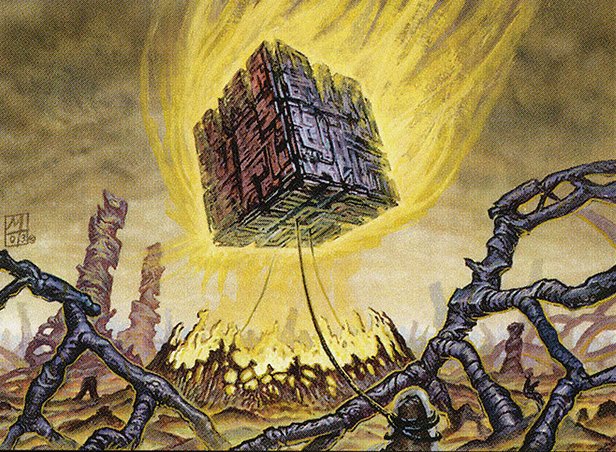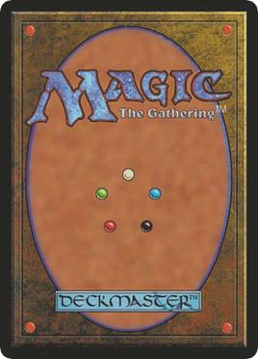 Art by Mark Tedin
Art by Mark TedinThis Cube was made mostly with cards we owned, in order to provide a renewable draft experience.
This article intends to give some advice for beginning drafters, to present the various draft archetypes available in the cube and the most iconic cards, in order to let drafters enjoy drafting even more. For those interested in such detail, I'll finish with some combos and interactions you might have overlooked.
FixingIn cube draft, cards are overall much more powerful than in a standard set draft. Therefore, picking cards that allow you to cast your powerful spells consistently is almost as important as picking said powerful spells. You can't reasonably expect to cast Gifted Aetherborn (cost: 
 ) turn 2 and Archmage's Charm (cost:
) turn 2 and Archmage's Charm (cost: 

 ) turn 3 without any help. There comes in mana fixing : cards that produce different colors of mana, and allow you to get the colors you need more consistently than your sole basic lands could.
) turn 3 without any help. There comes in mana fixing : cards that produce different colors of mana, and allow you to get the colors you need more consistently than your sole basic lands could.
Imagine the same situation - you have Gifted Aetherborn and Archmage's Charm in hand - but you also have Navigator's Compass and Sunken Ruins. Thanks to these two cards, you'll be able to play your spells on curve (the 2 mana spell on turn 2, the 3 mana one on turn 3).
The best fixing is often lands, because they don't take additional slots in your deck like Navigator's Compass would. There are 3 lands for each 2-colors pair, 1 land for each 3-colors combination (which you can play in any deck playing at least 2 of the 3 colors), and a few additional lands - for the most part good in any color combination. Fixing is so important that it's sometimes good to take Evolving Wilds as your first pick: it will be good in any deck you play, and it lets you stay open (not choose your colors too fast).
There are also some artifacts and creatures (exclusively green) that provide fixing.
ArchetypesThese are the predefined archetypes implemented in the cube. These are guidelines more than anything, and if you happen to draft something else, it's great.
 "Weenies" - Aggro / Soldiers
"Weenies" - Aggro / Soldiers
This archetype is pretty straightforward : play cheap, aggressive (Adanto Vanguard), taxing (Ethersworn Canonist) and protective (Mother of Runes) creatures, buff them (Veteran Swordsmith, Venerated Loxodon) and hopefully kill your opponent.
There are some synergies involving the creature type Soldier, although it's still a work in progress.
 Aggro / Goblins
Aggro / Goblins
This is the other monocolored, aggressive archetype in the cube. Use cards such as Goblin Instigator and Legion Warboss to flood the board with goblins, then throw them at the opponent's face with Siege-Gang Commander, Pashalik Mons and Impact Tremors.
Red burn spells gives you reach - a way to finish the game if your creatures get killed or your opponent has too many blockers.

 Aggro
Aggro
This archetype is pretty much a mixture of the mono  and mono
and mono  decks. You loose the Soldier/Goblin tribal aspect for more raw power and two colors in which you can pick cards. Tajic, Legion's Edge is one of the best aggressive creatures in the cube. Showdown of the Skalds gives you some much-needed card draw, and Aurelia's Fury is a great way to get rid of blockers and swing in for lethal.
decks. You loose the Soldier/Goblin tribal aspect for more raw power and two colors in which you can pick cards. Tajic, Legion's Edge is one of the best aggressive creatures in the cube. Showdown of the Skalds gives you some much-needed card draw, and Aurelia's Fury is a great way to get rid of blockers and swing in for lethal.

 Blink
Blink
The goal of this deck is to abuse ETB (Enter the Battlefield) triggers to draw cards and gain board presence. Cards such as Reflector Mage, Elite Guardmage and Mulldrifter have great ETB triggers while Soulherder, Ephemerate and Ghostly flicker allow you to reuse these ETB.
Although the best cards for this archetype are 
 , you might want to splash (play a few cards of another color)
, you might want to splash (play a few cards of another color)  or
or  to get access to other very powerful ETB creatures.
to get access to other very powerful ETB creatures.


No clearly defined archetype.

 Tokens + Enchant
Tokens + Enchant
There are two mixed archetypes in this color pair. "Tokens" tries to go wide with token generators such as Emmara, Soul of the Accord and Battle Screech, then either make these creatures bigger (Mirror Entity) or use them to get even more mana and creatures (Song of Freyalise, Martyr's Soul).
The "Enchant" archetype revolves around playing enchantment spells (ex: Elspeth Conquers Death), and sometimes more specifically auras (Warbriar Blessing, Hyena Umbra) and cards that benefit from these enchantments (Archon of Sun's Grace, Calix, Destiny's Hand, All that glitters).
Some bridge cards allow you to use both synergies in the same deck, and thus are to be picked more highly when drafting.

 Control
Control
Play removal (Doom Blade), counterspells (Counterspell) and sweepers (Ritual of Soot) to get to your powerful late-game (Liliana, Dreadhorde General).
You will also need card draw spells in order to keep drawing answers to your opponent's threat.

 Spells
Spells
Cards such as Firemind's Research, Wee Dragonauts and Aria of Flame reward you for having lots of cheap instants and sorceries, especially card draw. The best are those you can cast again from your graveyard (see Throes of Chaos, Scour all Possibilities).
Cheap red removal and cantrips (cheap instants and sorceries which draw a card) are at their best here.

 (Ramp)
(Ramp)
This archetype isn't fully polished yet.
The idea is to ramp (Llanowar Elves, Maraleaf Pixie, Kiora, Behemoth Beckoner) into a game-winning top-end (Expropriate, Artisan of Kozilek, Inscription of Insight).


 Reanimator
Reanimator
A reanimator deck is a combo deck that revolves around dumping big, game-ending creatures in your graveyard, then return them to the battlefield with cards such as Dread Return. Your primary color is necessarily  , since all reanimate effects are in
, since all reanimate effects are in  , but you can choose either
, but you can choose either  or
or  (or both) as your secondary color. Because this is a combo deck, it is often trickier to draft than other decks, so I'll give a little more advice than for the other archetypes.
(or both) as your secondary color. Because this is a combo deck, it is often trickier to draft than other decks, so I'll give a little more advice than for the other archetypes.
The first thing you need to do is putting creatures cards in your graveyard. Some of the cards that allow you to do that are generically good (Faithless Looting, Fact or Fiction) and as such good cards to pick early in the draft, when you're not sure to draft reanimator yet. Other are very specific to this archetype (Buried Alive, Olivia's Dragoon), and bad in other decks. Since Reanimator is the only archetype that wants these cards, there are good odds other players won't pick them and you will get them on the wheel (the second time the pack comes to you). Many cards allow you to discard cards or to mill cards although it isn't their primary goal, so keep reanimator in mind when you read such cards.
You also need the creatures you want to put in there. Cards like Bringer of the Black Dawn, Akroma, Angel of Wrath and Ulamog's Crusher will win you the game quickly if your opponent doesn't have removal for them. You can also opt for cards with powerful ETB triggers, such as Meteor Golem and Dinrova Horror. Waker of Waves is great because its ability allows you to discard it without the need for another card.
Next, you need a way to bring these creatures back to the battlefield. Exhume and Animate Dead are the best way to reanimate a single creature, while Living Death and Command the Dreadhorde are mass reanimation effects. Living Death also serves the purpose of killing your opponent's creatures to keep you alive.
Because you need to find specific combo pieces, card draw and card selection are very important. Spellseeker is a great way to find either Faithless Looting or Exhume, and Bitter Revelation lets you dig for reanimation spells whilst throwing creatures in your graveyard. You also need to stay alive while you setup for reanimation, so removal (especially in creature form so you can reanimate it) and deathtouch creatures go up in value.

 Graveyard matters
Graveyard matters
This is all about using your graveyard as a resource to gain card advantage. The best way to understand that is by looking at The Gitrog Monster and Baloth Null. You can abuse the symmetry of Rankle, Master of Pranks, and win the game with recursive threats such as Multani, Yavimaya's Avatar.
Deathtouch creatures are especially good in this archetype, because you can trade them in combat then get them back to your hand and repeat. Cards that mill you are also better since there is a good chance you end up getting back to your hand the cards you milled.

 Agro/Midrange
Agro/Midrange
This color pair is less aggressive than 
 , and can play more mid-range. Experiment One and Burning-Tree Emissary can allow very explosive starts, while Llanowar Elves and Elves of Deep Shadow can accelerate your game to hit harder and sooner.
, and can play more mid-range. Experiment One and Burning-Tree Emissary can allow very explosive starts, while Llanowar Elves and Elves of Deep Shadow can accelerate your game to hit harder and sooner.
More ramp (Dryad of the Ilysian grove, Sakura-Tribe Elder) can get you to very powerful creatures in Glorybringer and Phylath, World Sculptor.
More advanced synergiesThese synergies only have little support in the cube, some of them are somewhat experimental. There are mostly about building around already powerful cards to make them even more powerful.

 Top of the deck matters
Top of the deck matters
Courser of Kruphix, Nylea, Keen-Eyed, Jace, Mirror Mage and Brainstorm are the four cards that reward you for having ways to shuffle your deck and to manipulate the top of your deck. With enough shuffle effects, Brainstorm is almost a draw 3 cards for  . Manipulating the top of your deck in such a way that you play a land each turn from the top of your deck with Courser of Kruphix gives you insane card advantage.
. Manipulating the top of your deck in such a way that you play a land each turn from the top of your deck with Courser of Kruphix gives you insane card advantage.
There are much more enablers than payoffs (which are pretty much limited to the four above). Brainstorm itself is both a payoff and an enabler for the other payoffs. Soothsaying and scry effects like Preordain are the most obvious way to get card advantage with the three other payoffs, but innocent shuffle effects are what really makes everything work: Terramorphic Expanse and Ash Barrens are some of the best cards to build around Brainstorm, Courser of Kruphix and Soothsaying, although they don't work as well with scry effects, Nylea and Jace.

 Siona Combo
Siona Combo
If you have Siona, Captain of the Pyleas on the battlefield and you play Shielded by Faith, you will have the possibility to make as many tokens as you want - and win the game in most cases. If you have picked these cards and wish to make the combo more consistent, be on the lookout for Heliod's Pilgrim (which can search for Shielded by faith) and Recruiter of the Guard (which can search either for Siona, Captain of the Pyleas or Heliod's Pilgrim).

